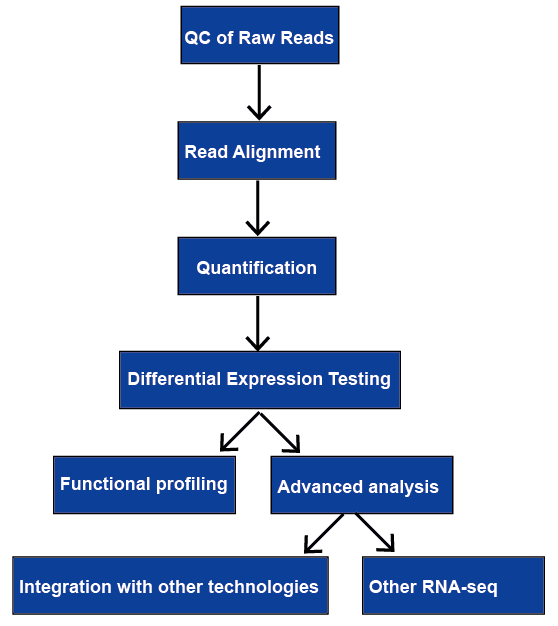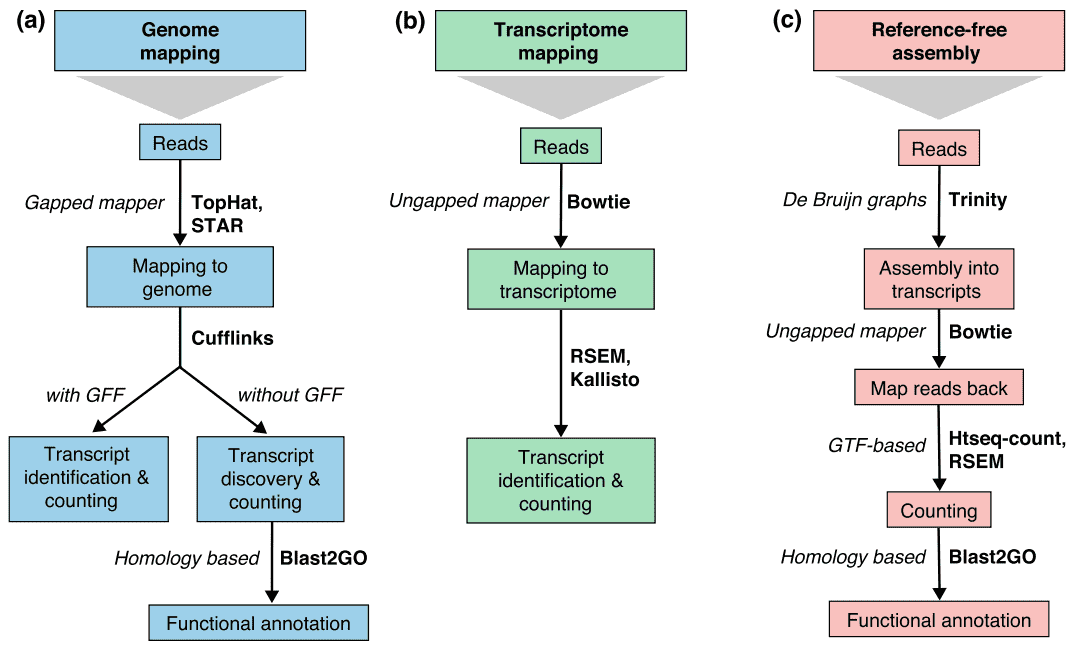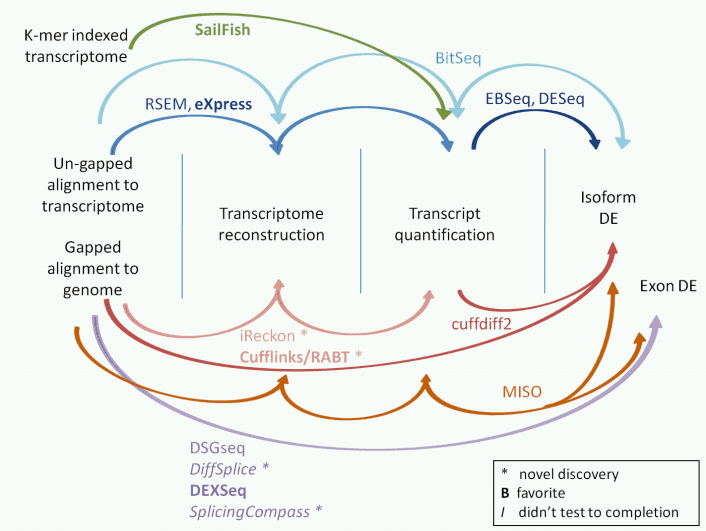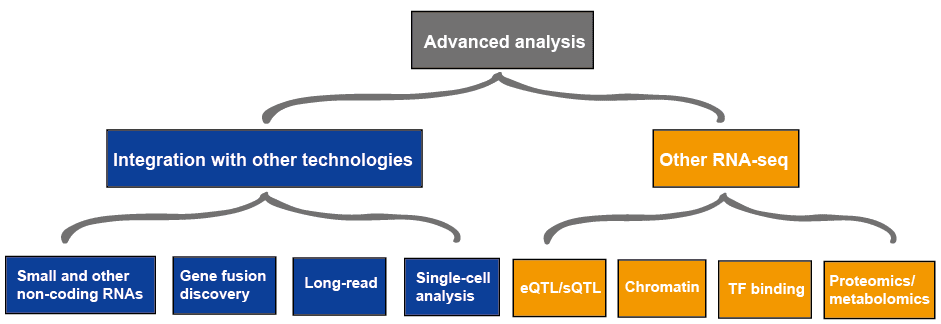RNA-sequencing (RNA-seq) has a wide range of
applications, and there is no optimal pipeline for all cases. We review all of the major steps in RNA-seq data
analysis, including quality control, read alignment, quantification of gene and transcript levels, differential gene
expression, functional profiling, and advanced analysis. They will be discussed later.

Figure 1.
The general workflow of RNA-seq analysis.
Quality control of raw reads
Quality control
of RNA-seq raw reads consists of analysis of sequence quality, GC content, adaptor content, overrepresented k-mers,
and duplicated reads, dedicated to detecting sequencing errors, contaminations, and PCR artifacts. Read quality
decreases towards the 3’ end of reads, bases with low quality, therefore, they should be removed to improve
mappability. In addition to the quality of raw data, quality control of raw reads also includes the analysis of read
alignment (read uniformity and GC content), quantification (3’ bias, biotypes, and low-counts), and reproducibility
(correlation, principal component analysis, and batch effects).
Table 1. The tools for quality
control of RNA-seq raw reads.
| Tools |
Applications |
| NGSQC |
Quality control of raw reads generated by Illumina platforms. |
| FastQC |
Quality control of raw reads generated by any platforms. |
| FASTX-Toolkit |
Discard of low-quality reads, trim adaptor sequences, and elimination of poor
quality bases.
|
| Trimmonmatic |
| Picard |
Quality control in read alignment, including the determination of read
uniformity and GC content.
|
| RSeQC |
| Qualimap |
| NOISeq |
Provide useful plots for quality control of count data. |
| EDASeq |
Read alignment
There are generally three strategies for read alignment, genome mapping,
transcriptome mapping, and de novo assembly.
Regardless of whether a genome or transcriptome reference is available, reads may map uniquely or be assigned to
multiple positions in the reference, which are referred to as multi-mapped reads or multireads. Genomic multireads
are generally due to repetitive sequences or shared domains of paralogous genes. Transcriptome multi-mapping arises
more often due to gene isoforms. Therefore, transcript identification and quantification are important challenges
for alternatively expressed genes. When a reference is not available, RNA-seq reads are assembled de novo
using packages such as SOAPdenovo-Trans, Oases, Trans-ABySS, or Trinity. PE strand-specific and long-length reads
are preferred since they are more informative. Emerging long-read technologies, such as PacBio SMRT sequencing and Nanopore
sequencing, can generate full-length transcripts for most genes.

Figure
2. Three basic strategies for RNA-seq read mapping (Conesa et al. 2016). Abbreviations: GFF, General
Feature Format; GTF, gene transfer format; RSEM, RNA-seq by Expectation Maximization.
Table 2.
The comparison of genome-based and de novo assembly strategies for RNA-seq analysis.
| |
Genome-based |
De novo assembly |
| Method |
Alignment to a reference genome |
Not using a reference genome |
| Advantages |
- Efficient computing
- Eliminates contaminating reads
- Very sensitive and can assemble transcripts of low abundance
- Can discover novel transcripts without annotation
|
- Reference genome is not required
- Correct alignment of reads to known splice site is not required
- Trans-spliced transcripts can be assembled
|
| Disadvantages |
Requires high-quality reference genome |
- More computational intense
- Sensitive to sequencing error
|
| Recommended depth |
Approximately 10x |
Beyond 30x |
Table 3. The public sources of RNA-seq data.
Transcriptomic Database |
Data Type |
Website |
| Gene Expression Omnibus (GEO) |
Both microarray and sequencing data |
https://www.ncbi.nlm.nih.gov/geo/ |
| ArrayExpress |
Both microarray and sequencing data |
https://www.ebi.ac.uk/arrayexpress/ |
| ENCODE: Encyclopedia of DNA Elements |
Public ENCODE Consortium data |
https://www.encodeproject.org/ |
| Sequence Read Archive (SRA) |
Sequencing data |
https://www.ncbi.nlm.nih.gov/sra |
| European Nucleotide Archive (ENA) |
Sequencing data |
https://www.ebi.ac.uk/ena |
| DDBJ Sequence Read Archive (DRA) |
Sequencing data |
https://www.ddbj.nig.ac.jp/dra |
Transcript quantification
Transcript quantification can be
used to estimate gene and transcript expression levels.
Table 4. The common tools for
transcript quantification.
| Tools |
Principles and Applications |
| TopHat |
Using an expectation-maximization approach that estimates transcript abundances. |
| Cufflinks |
Designed to take advantage of PE reads, and may use GTF information to identify expressed
transcripts, or can infer transcripts de novo from the mapping data alone.
|
| RSEM |
Quantify expression from transcriptome mapping.
Allocate multi-mapping reads
among transcript and output within-sample normalized values corrected for sequencing biases.
|
| Sailfish |
| kallisto |
| NURD |
Provides an efficient way of estimating transcript expression from SE reads with a low
memory and computing cost.
|

Figure
3. The tools for isoform expression quantification.
Differential expression testing
Differential expression testing is used to evaluate if one gene is differentially expressed in one condition
compared to the other(s). Normalizing methods need to be adopted before comparing different samples. RPKM and TPM
normalize away the most important factor, sequencing depth. TMM, DESeq, and UpperQuartile can ignore highly variable
and/or highly expressed features. Other factors that interfere with intra-sample comparisons involve transcript
length, positional biases in coverage, average fragment size, and GC content, which can be normalized by tools, such
as DESeq, edgeR, baySeq, and NOISeq. Batch effects may still be present after normalization, which can be minimized
by appropriate experimental design, or removed by methods such as COMBAT or ARSyN.
Table 5.
The normalization tools for differential expression testing.
Package |
Read count distribution assumptions |
Input |
Replicates |
Normalization |
| DESeq |
Negative binomial distribution |
Raw counts |
No |
Library size |
| edgeR |
Bayesian methods for negative binomial distribution |
Raw counts |
Yes |
Library size
TMM
RLE
Upperquartile |
| baySeq |
Bayesian methods for negative binomial distribution |
Raw counts |
Yes |
Library size
Quantile
TMM |
| NOISeq |
Non-parametric |
Raw or normalized counts |
No |
Library size
RPKM
TMM
Upperquartile |
Alternative splicing analysis
Alternative splicing (AS) is a posttranscriptional
process which generates different transcripts from the same gene and is vital in response to environmental stimuli
by producing diverse protein products. Multiple bioinformatics tools have been developed to detect AS from
experimental data. The comparison of these detection tools using RNA-seq data was conducted by Ding in 2017, and the
results are shown in Table 7. They have demonstrated that TopHat and its downstream tool, FineSplice, are the
fastest tools, whereas PASTA is the slowest program. Furthermore, AltEventFinder can detect the highest number of
junctions, and RSR detects the lowest number of junctions. Other tools, such as TopHat, are likely to detect false
positive ones. Of the two tools that detect differentially spliced isoforms, rMATS is faster than rSeqDiff but
detects less differentially spliced isoforms than rSeqDiff.
Table 7. Detected AS types or
differentially spliced isoforms of these tools (Ding et al. 2017).
| Tool |
Data Source |
Running Time (Minutes) |
Maximum
Memory (GB) |
Maximum CPU (%) |
Number of SJs |
Number of
Differentially Spliced Isoforms
|
| Alt Event Finder |
ENCODE |
12 |
1.364 |
100 |
30569 |
N/A |
| SpliceMap |
ENCODE |
42 |
3.1 |
99.9 |
11882 |
N/A |
| FineSplice |
ENCODE |
2 |
1.364 |
100 |
8577 |
N/A |
| RSW |
N/A |
N/A |
N/A |
N/A |
N/A |
N/A |
| RSR |
ENCODE |
24 |
3.968 |
100 |
3143 |
N/A |
| PASTA |
ENCODE |
350 |
2.17 |
101 |
14675 |
N/A |
| rMATS |
mouse used in RSW study |
44 |
26.536 |
274 |
N/A |
17 |
| SOAPsplice |
ENCODE |
123 |
5.332 |
99.7 |
10381 |
N/A |
| SplicePie |
N/A |
N/A |
N/A |
N/A |
N/A |
N/A |
| SplicingCompass |
N/A |
N/A |
N/A |
N/A |
N/A |
N/A |
| TopHat |
ENCODE |
1.75 |
1.364 |
100 |
9619 |
N/A |
| TrueSight |
ENCODE |
229 |
2.914 |
571 |
12360 |
N/A |
| NSMAP |
N/A |
N/A |
N/A |
N/A |
N/A |
N/A |
| rSeqDiff |
mouse used in RSW study |
115 |
0.186 |
119 |
N/A |
203 |
| rSeqNP |
N/A |
N/A |
N/A |
N/A |
N/A |
N/A |
Visualization
There are many bioinformatics tools for the visualization of RNA-seq
data, including genome browsers, such as ReadXplorer, UCSC browser, Integrative Genomics Viewer (IGV), Genome Maps,
Savant, tools specifically designed for RNA-seq data, such as RNAseqViewer, as well as some packages for
differential gene expression analysis that enable the visualization, such as DESeq2 and DEXseq in Bioconductor.
Packages, such as CummeRbund and Sashimi plots, have also been developed for visualization-exclusive purposes.
Functional Profiling
The latest step in a standard transcriptomics study is generally the
characterization of the molecular functions or pathways in which differentially expressed genes are involved. Gene
Ontology, Bioconductor, DAVID, or Babelomics contain annotation data for most model species, which can be used for
functional annotation. As for novel transcripts, protein-coding transcripts can be functionally annotated using
orthology with the help of databases such as SwissProt, Pfam, and InterPro. Gene Ontology (GO) allows for some
exchangeability of functional information across orthologs. Blast2GO is a popular tool that allows massive
annotation of complete transcriptome against a variety of databases and controlled vocabularies. The Rfam database
contains most well-characterized RNA families that can be used for functional annotation of long non-coding
RNAs.
Advanced analysis
The advanced analysis of RNA-seq usually includes other
RNA-seq and integration with other technologies, which is outlined in Figure 4. More information on applications of
RNA-seq, please view this article Applications of RNA-Seq.
Figure 3. The advanced analysis of RNA-seq data.

Our experienced bioinformatics scientists are skilled in utilizing the advanced bioinformatics tools to deal
with the numerous sequences generated by the next and third generation sequencing. We provide both sequencing and bioinformatics services for genomics,
transcriptomics, epigenomics, microbial genomics, single-cell
sequencing, and PacBio SMRT sequencing.
References:
- Conesa A, Madrigal P, Tarazona S, et al. A survey of best practices for RNA-seq data analysis. Genome
biology, 2016, 17(1): 13.
- Ding L, Rath E, Bai Y. Comparison of Alternative Splicing Junction Detection Tools Using RNASeq Data. Current
genomics, 2017, 18(3): 268-277.
- Grabherr M G, Haas B J, Yassour M, et al. Full-length transcriptome assembly from RNA-Seq data without
a reference genome. Nature biotechnology, 2011, 29(7): 644.
For research purposes only, not intended for clinical diagnosis, treatment, or individual health assessments.


 Sample Submission Guidelines
Sample Submission Guidelines




